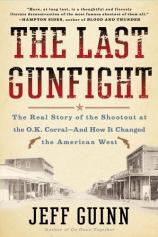The Last Gunfight: The Real Story of the Shootout at the O.k. Corral --- and How It Changed the American West
Review
The Last Gunfight: The Real Story of the Shootout at the O.k. Corral --- and How It Changed the American West
An old Italian proverb roughly translates: "If it is not true it should be." Put in another fashion is the famous observation from the movie The Man Who Shot Liberty Valance: "This is the West, sir. When the legend becomes fact, print the legend." The gunfight at the O.K. Corral is the stuff of legends, evoking a tale of a classic battle on the streets of Tombstone, Arizona, between the warring Earp and Clanton families. But the truth of the gunfight was far different from the legend. Indeed, the actual tale of the shooting would not even make a blip on the history radar were it not for subsequent portrayals based solely on myth rather than fact. The myths are the foundations upon which the legends are built.
While historical accounts and modern portrayals of the shooting in Tombstone are more fiction than fact, THE LAST GUNFIGHT by Jeff Guinn places the event in its historical context, offering significant insight into the true nature of the West in the late 1800s as America's continental expansion reached completion. History teaches us that the "wild west" was not as depicted in many movies and books. Cowboys did not roam the streets of communities such as Tombstone drawing down and shooting other cowboys. Actually, Tombstone had a gun ordinance in 1881, and most visitors to the city were required to surrender their weapons upon arrival. It was confusion about carrying and surrendering weapons that contributed to the O.K. Corral shooting, but as Guinn correctly notes, it was not the Clantons and Earps facing each other, drawing and shooting. In fact, it was 30 shots fired in mass confusion in around 30 seconds.
Reading THE LAST GUNFIGHT, one is struck by how little has changed in American history. The story of Tombstone is that of political infighting, personal battles and money. Guinn traces the growth of the mining industry in Arizona and the huge income generated in the area by successful prospectors. In the 1880s, silver was the "dot com" commodity of its generation. Drawn to Arizona by the prospect of wealth and law enforcement employment were the Earp brothers: Wyatt, James, Morgan, Virgil and Warren. During this era, law enforcement was a lucrative profession because sheriffs were often paid a percentage of the various taxes collected. Whether elected or appointed, those seeking law enforcement positions often resorted to tactics that led to bitter feelings. Indeed, the jealousy and bad feelings among several of the law enforcement agencies involved contributed to the confusion that led to the shootings at 3:00 p.m. on October 26, 1881.
The actual gunfight was the result of a festering dispute between the Earps and a group of men known to Tombstone citizens as Cowboys. The Cowboys, some of whom were Clantons, were suspected of stealing Army mules and robbing a stagecoach where a guard was shot and killed. Wyatt Earp tried to convince the Clantons to help him bring the robbers to justice. There was reward money available, but Earp was more interested in the political benefit his campaign for Sheriff would receive.
THE LAST GUNFIGHT is entertaining and well written. In its discussion of how the gunfight grew in mythical proportions years after the shooting, Jeff Guinn completes the cycle of the saga. Self-promotion by Masterson and Wyatt Earp coupled with the general myths of the Wild West that grew in the early 20th century helped propagate the myth. Citizens of Tombstone and Hollywood producers were all too happy to benefit. The real story is certainly not as glamorous, but Guinn tells it well in this wonderful book.
Reviewed by Stuart Shiffman on May 24, 2011
The Last Gunfight: The Real Story of the Shootout at the O.k. Corral --- and How It Changed the American West
- Publication Date: May 17, 2011
- Genres: History, Nonfiction
- Hardcover: 416 pages
- Publisher: Simon & Schuster
- ISBN-10: 1439154244
- ISBN-13: 9781439154243





